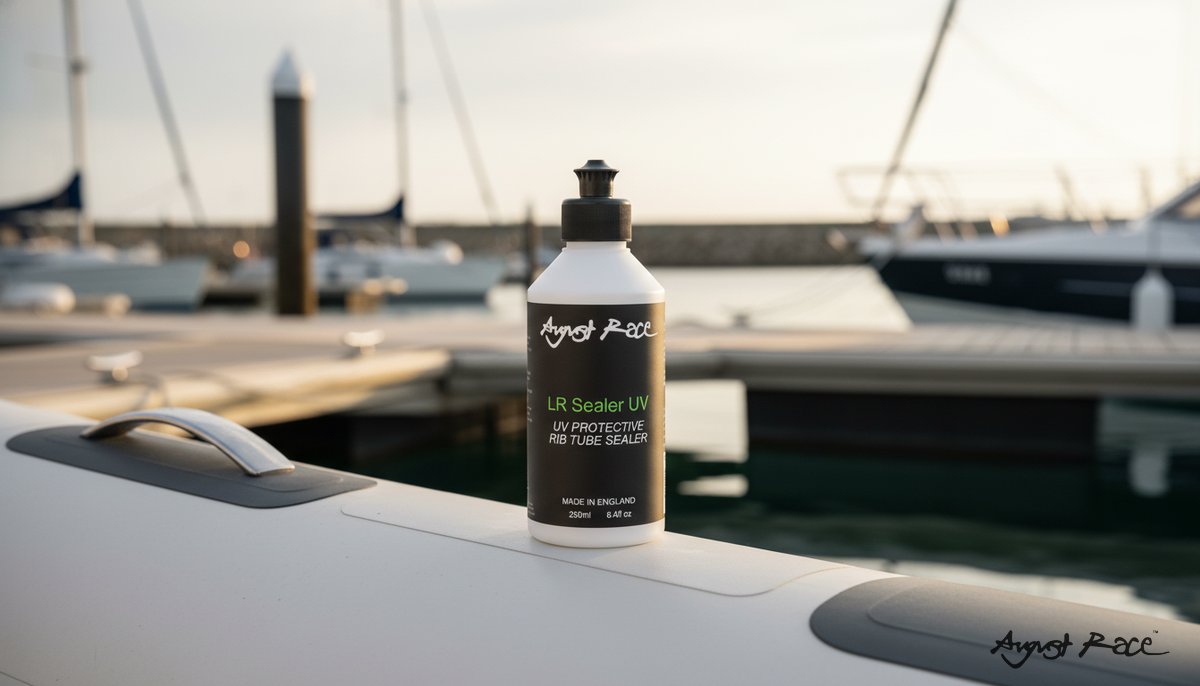How August Race LR Sealer UV Protects RIB Tubes from UV Damage: A RIB UV Protection Guide
Keeping inflatable tubes in good condition is a core part of RIB UV protection. Sunlight, heat, and salt combine to fade, dry, and weaken PVC and Hypalon over time. A purpose-made surface sealer such as LR Sealer UV can be an important part of a preventive care routine to maintain appearance and slow degradation. As a PVC tube sealer and Hypalon UV treatment, it is designed to support both common RIB fabrics.
Why UV Protection Matters for RIB Owners
RIBs spend long periods under direct sun, in reflective glare on open water, and subjected to salt spray and frequent washdowns. These conditions accelerate UV-related wear on tube surfaces. Over months and seasons, the result can include visible fading, a chalky surface feel, and loss of flexibility.
UV radiation drives photo-oxidation in polymers. On PVC and Hypalon tubes, that process shows up as surface embrittlement, color change, and, if left unmanaged, cracking. Owners also see extra time spent on cleaning and, eventually, seam issues or repairs if degradation reaches welded or bonded areas.
Those risks translate to cost -- both in hours of maintenance and in earlier-than-planned tube replacement. A dedicated sealer forms part of a simple, preventive protocol: clean, protect, and maintain. Incorporating a sealer designed for RIB UV protection helps prevent UV cracking on RIB tubes and slows the cycle of wear that leads to repairs.
PVC vs. Hypalon: How UV Damages Each Material
PVC-coated fabric and Hypalon (CSM) are common on RIBs, but they are chemically different. PVC is a thermoplastic polymerized with plasticizers and stabilizers; Hypalon is a synthetic rubber (chlorosulfonated polyethylene/CSM) renowned for broader solvent and weather resistance. These differences affect UV resilience and failure modes.
Typical UV-related issues on PVC include:
- Surface chalking and fading as stabilizers and plasticizers migrate
- Micro-cracking and embrittlement, especially on high-stress curves
- Weld seam stress where expansion/contraction cycles concentrate strain
- Accelerated surface wear that can complicate future bonding or repairs
For Hypalon, long-term UV exposure commonly leads to:
- Color fading and a dull, oxidized finish
- Gradual loss of surface flexibility and minor surface checking over very long exposures
Seams and welded joints on any tube are additional weak points. Thermal cycles and movement focus stress at overlaps and welds. As a result, many owners look for an approach that supports anti seam failure goals by shielding surfaces, moderating UV impact, and preserving flexibility at joints.
What August Race LR Sealer UV Does: Key Properties
LR Sealer UV is formulated as a protective sealer for PVC and Hypalon tubes. While you should always consult the product datasheet for exact specifications, sealers in this class are designed to provide three main benefits:
- UV-screening and stabilization: A protective layer helps reduce the amount of UV that reaches the substrate, moderating photo-oxidation.
- Durable, flexible film: A thin polymer film forms on the surface to help limit water intrusion, reduce surface abrasion, and maintain flexibility during tube movement.
- Water- and soil-repellent finish: Improved beading and lower surface energy can make routine rinsing more effective and help reduce RIB cleaning frequency.
How this supports both materials:
- On PVC, a UV-protective film can slow the loss of plasticizers and reduce surface embrittlement, helping to prevent UV cracking on RIB tubes.
- On Hypalon, a stabilized, flexible coating can help slow oxidative fading and support the rubber’s integrity during long exposures, which supports efforts to extend Hypalon tube life.
Attention to seams:
- Seams experience movement, flex, and local heating. A flexible, surface-bonded film helps accommodate that motion and provides additional coverage where stress concentrates, supporting anti seam failure objectives when combined with sound seam construction and care.
Compatibility guidance:
- Intended uses include PVC and Hypalon tube fabrics. As with any treatment, test on a small, inconspicuous area first to confirm appearance and adhesion. Follow manufacturer instructions for prep, application, and cure. Avoid use on acrylic windows, decals, or areas the datasheet excludes.
Related surfaces:
- For gelcoat hulls and topsides, see GRP Sealer UV for a complementary gelcoat UV protective sealant.
How to Apply LR Sealer UV for Best Results
Preparation is essential. A sealer locks in whatever is on the surface -- clean or contaminated -- so thorough prep makes the difference between a smooth, even finish and patchy results.
Surface preparation
- Rinse to remove salt and loose grime.
- Clean with a tube-safe cleaner or the brand’s recommended cleaner, such as Liquid RIB cleaner. Avoid harsh solvents unless the manufacturer approves them.
- Degrease lightly if needed to remove sunscreen, fuel residue, or silicone. Rinse and allow to dry fully.
- Inspect for existing damage. Address deep cracks, loose welds, or lifted seams with appropriate repairs before sealing.
Application technique
- Work in shade on a cool, dry surface. Mask adjacent hardware to keep edges clean.
- Apply thin, even coats using a lint-free cloth, foam applicator, soft brush, or a low-pressure sprayer if permitted by the datasheet.
- Follow the product’s guidance for coverage rate, drying, and time between coats. As a general best practice, allow the first coat to flash off and lay a second light coat for uniform protection. Allow a full cure before launch or heavy use.
Seam-specific tips
- Pay deliberate attention to welds and overlaps. Lay the applicator along the seam to ensure continuous coverage without puddling.
- Avoid forcing the tube into tight bends during curing. Gentle, natural alignment helps the film set while accommodating movement.
- Steer clear of high humidity and dew during application and early cure to minimize streaking or cloudiness.
Maintenance cadence
- Reapplication frequency depends on UV intensity, storage, and use. Many owners plan a seasonal application and add a mid-season top-up in high-UV regions.
- Rinse with fresh water after use and clean with a mild, tube-safe shampoo as needed. A well-maintained sealed surface can reduce RIB cleaning frequency by helping grime release more readily. For general washdowns, a neutral cleaner like August Race Boat Wash Pro can support routine care.
- Inspect seams and high-wear zones routinely; touch up those areas first if you notice dulling or higher friction during cleaning.
Expected Benefits: Extending Tube Life and Lowering Maintenance
Owners typically look for two results: protection that slows visible UV damage and practical gains in day-to-day upkeep. When applied and maintained as directed, a UV sealer can help reduce fading, delay the onset of surface cracking, and make routine rinsing more effective.
For PVC and Hypalon alike, moderating UV exposure contributes to longer service life. A more stable surface means fewer cosmetic issues and less stress at seams, which can translate into fewer repairs over the life of the tubes.
Expectations should be set by your conditions. Boats stored outdoors in tropical sun will require more frequent care than those kept under cover in temperate climates. Storage practices, original material quality, and overall maintenance (pressure management, cleaning, and repair) all influence outcomes. A sealer is one element of a comprehensive plan to extend Hypalon tube life and help prevent UV cracking on RIB tubes.
Safety, Compatibility, and Common Concerns
Safety first
- Use in a well-ventilated area. Wear gloves and eye protection. Avoid ignition sources if the product is solvent-based.
- Store sealed, away from heat and sunlight, and keep out of reach of children.
Material compatibility
- Verify suitability for your tube fabric -- PVC or Hypalon -- and for any repainted or patched areas. Test a small area to confirm no discoloration or softening.
- If your tubes have been repaired, ensure adhesives and patches are fully cured before sealing to avoid interference.
Warranty and repairability
- Some manufacturers specify approved treatments. If your RIB is under warranty, check documentation or contact the builder before applying any coating.
- If future repairs are likely, note that surface treatments can affect bonding; cleaning or light abrasion may be needed before a patch. Follow repair instructions from your tube manufacturer or technician.
Troubleshooting
- Streaking or patchy gloss often indicates uneven prep or application in direct sun. Allow to cure, then clean and apply a light leveling coat in shade.
- Poor adhesion suggests residual oils or silicone. Degrease, rinse, and reapply to a small test area.
- Unexpected reaction or dulling: stop, allow to cure, and consult the datasheet or supplier before proceeding.
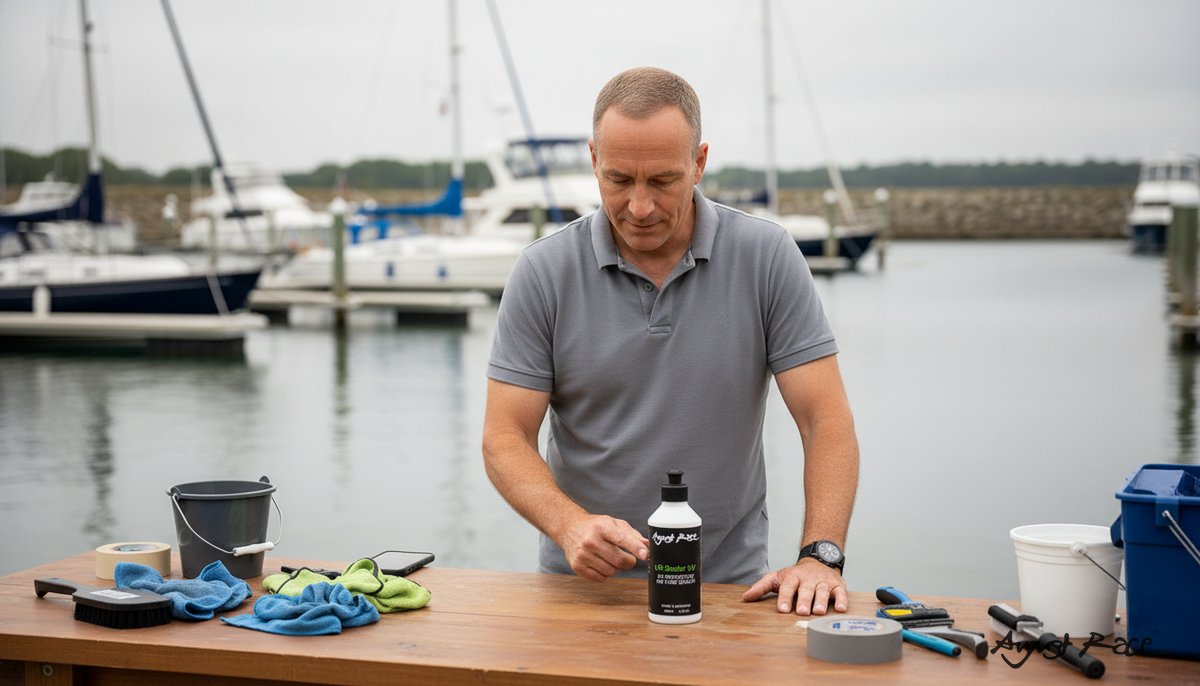
Next Steps: Testing and Scheduling Sealer Application
- Perform a small spot test in an inconspicuous area to validate adhesion, sheen, and color. Confirm that the finish meets your expectations before proceeding.
- Plan your schedule around your local UV index and storage. A pre-season application sets a baseline; high-exposure users can plan a mid-season refresh. Off-season, clean and inspect to decide on re-coating needs.
- Review the technical datasheet for LR Sealer UV and, if needed, consult a professional rigger or marine technician -- especially if your tubes have prior coatings or complex repairs.
- Take action: obtain the LR Sealer UV technical datasheet or request a small quantity for testing before a full application. This supports a low-risk, data-driven decision on the best sealer for PVC RIB tubes in your conditions.
Conclusion
Protecting your tubes from sunlight is central to RIB UV protection. With thorough surface prep, careful application, and routine maintenance, LR Sealer UV can help slow UV-related wear on PVC and Hypalon, support seam integrity, and make day-to-day cleaning easier. A simple test patch and seasonal plan turn this guidance into practical steps to preserve appearance and performance over time.
FAQs
How can I prevent UV cracking on RIB tubes using a sealer?
Apply a UV-focused sealer to clean, dry tubes in thin, even coats, with extra attention along seams and high-sun areas. Maintain a seasonal reapplication schedule based on exposure, and pair sealing with regular rinsing, shade or cover when berthed, and correct tube pressure.
What is the best sealer for PVC RIB tubes and how often should I reapply it?
The best sealer for PVC RIB tubes is one formulated specifically for PVC and marine UV exposure, such as LR Sealer UV. Reapply on a schedule that matches your climate and usage -- often once per season, with a mid-season top-up in high-UV regions; always follow the product datasheet.
Can UV treatment extend Hypalon tube life without affecting seams or warranties?
A compatible UV treatment can help extend Hypalon tube life by moderating surface oxidation and preserving flexibility, including around seams. Always confirm compatibility with your manufacturer and warranty terms, test a small area first, and follow guidance to avoid impacting future repairs or coverage.
About the Author
August Race Team
The August Race professional team brings decades of marine industry expertise and product development knowledge.
Get Expert Tips
Subscribe for marine care insights and product updates from industry professionals.
No spam. Unsubscribe anytime.
You May Also Like
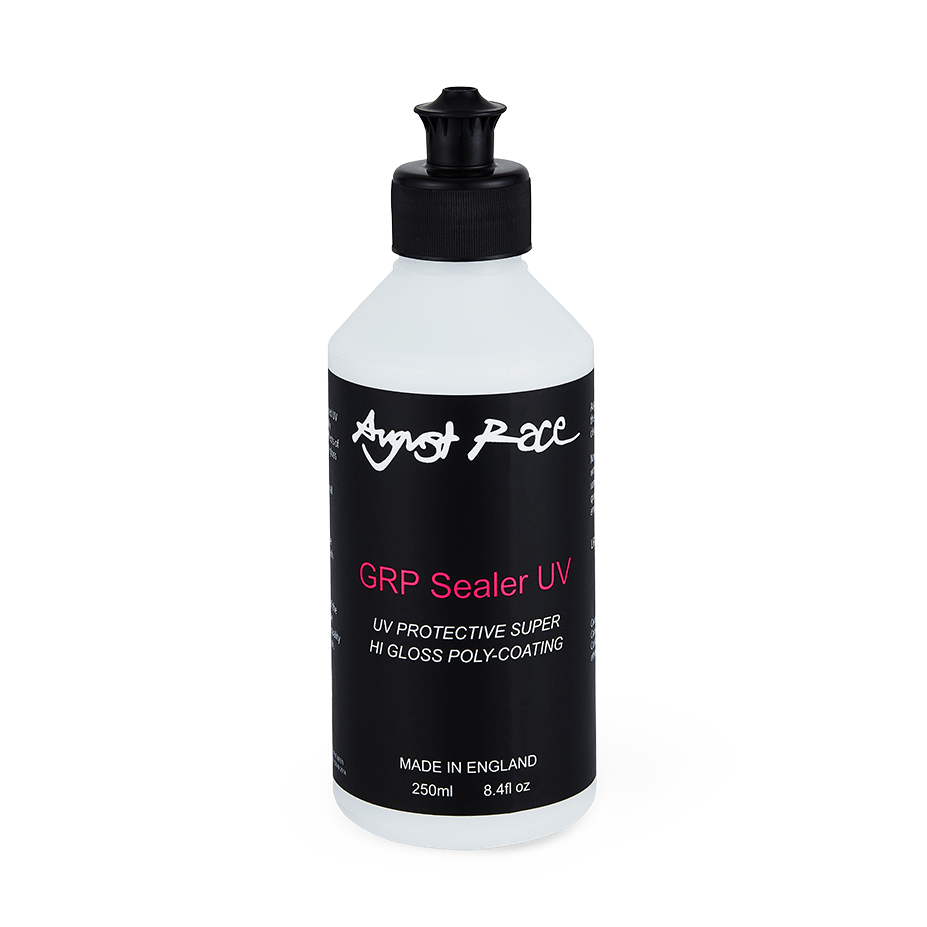
GRP UV Protection: August Race GRP Sealer UV Guide
Protect fiberglass boats from UV with a hydrophobic, eco-friendly GRP sealer. Prep, application, maintenance tips, and FAQs on water spots and durability.
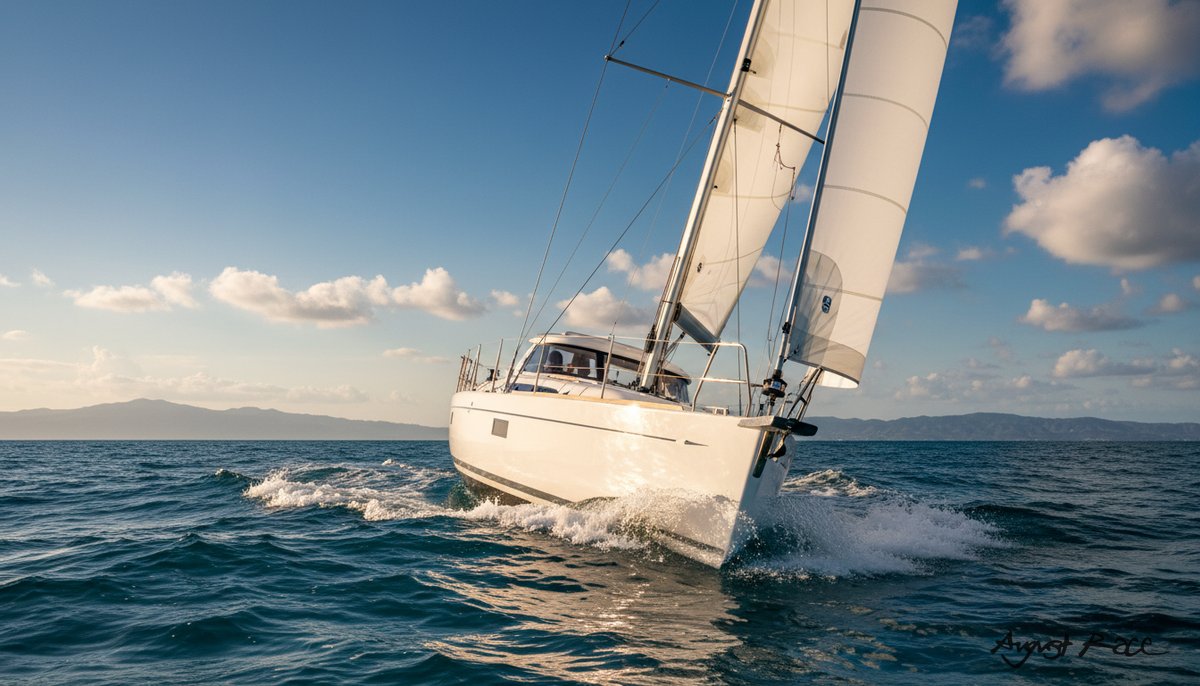
August Race GRP Sealer UV: Scalable GRP UV Protection
Protect GRP fleet-wide with a biodegradable, hydrophobic fiberglass sealant. Faster washdowns, longer gloss, and scalable SOPs for busy marinas.
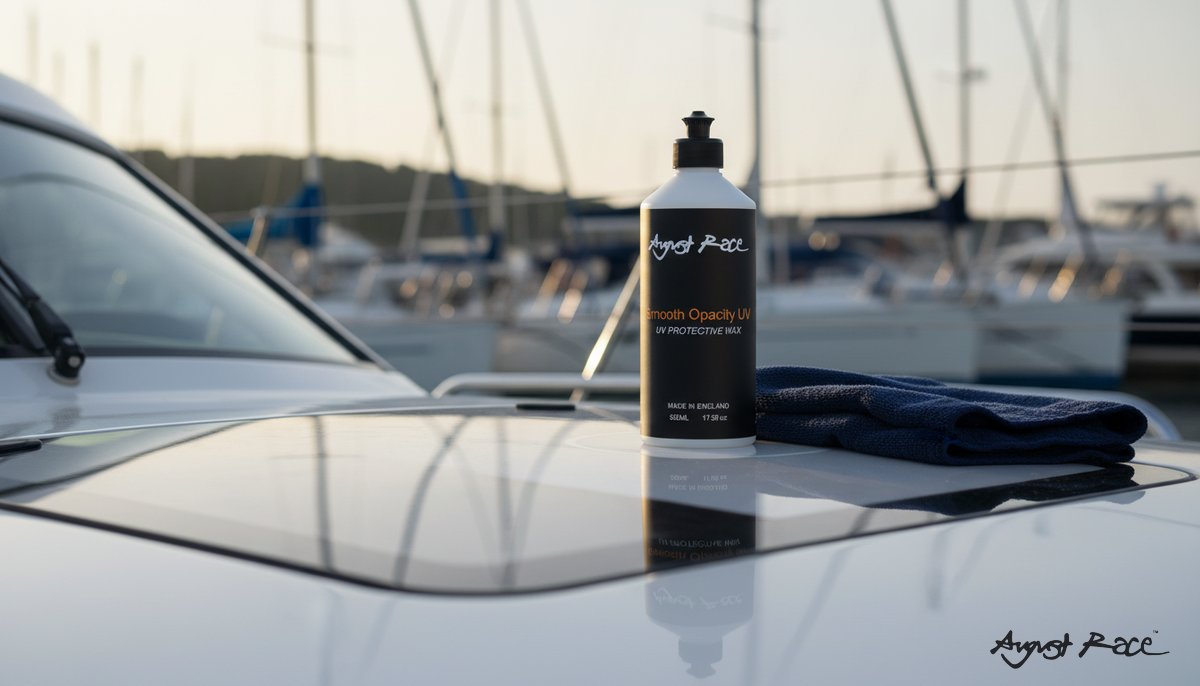
Smooth Opacity UV: Pro UV Protection Boat Wax Guide
A marine tech’s guide to Smooth Opacity UV -- UV protection boat wax and hydrophobic boat polish for gelcoat. Improve gloss, repel water, and extend service...
